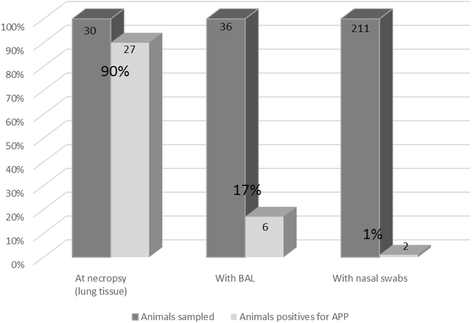Randomised controlled field study to evaluate the efficacy and clinical safety of a single 8 mg/kg injectable dose of marbofloxacin compared with one or two doses of 7.5 mg/kg injectable enrofloxacin for the treatment of Actinobacillus pleuropneumoniae infections in growing-fattening pigs in Europe
- PMID: 28496988
- PMCID: PMC5424389
- DOI: 10.1186/s40813-017-0057-2
Randomised controlled field study to evaluate the efficacy and clinical safety of a single 8 mg/kg injectable dose of marbofloxacin compared with one or two doses of 7.5 mg/kg injectable enrofloxacin for the treatment of Actinobacillus pleuropneumoniae infections in growing-fattening pigs in Europe
Abstract
Background: Acute outbreaks of Actinobacillus pleuropneumoniae (APP) require rapid, effective, parenteral antimicrobial treatment. The efficacy and safety of a single, short-acting, high dose of marbofloxacin (Forcyl® swine 160 mg/mL) compared with 1 or 2 doses of 7.5 mg/kg enrofloxacin in APP outbreaks in European farms was studied.
Methods: A controlled, randomised block, blinded, multicentre, field study was conducted on four farms with acute respiratory disease associated with APP. Animals with clinical signs of respiratory disease were allocated similarly to intramuscular treatments of either a single dose 8 mg/kg marbofloxacin on day 0 or, 7.5 mg/kg enrofloxacin (Baytril 1nject®) on day 0 and again on day 2, if clinical signs had not improved.
Results: The results were similar for intention to treat (242 pigs) and per protocol populations (239 pigs). On day 0, all pigs had pyrexia (means, 40.6 °C), moderate to severe clinical signs (depression, cough, dyspnoea). Following treatment, animals improved rapidly and on day 7, clinical signs were absent or mild in all pigs and mean temperatures for each treatment were <39.5 °C (P > 0.05). The primary efficacy criterion, animals cured, for marbofloxacin and enrofloxacin was 81.8 and 81.4% on day 7, and 84.2 and 82.2% on day 21, respectively. Results for cure, respiratory disease removals and mortalities, and relapses were compared using confidence intervals and confirmed that marbofloxacin was non-inferior to enrofloxacin (P > 0.05). There were no significant treatment differences in live weight gains, adverse events and injection site reactions (<2.5% animals) (P > 0.05). Significantly more animals developed concurrent disorders in the enrofloxacin (7.5%) than marbofloxacin (0.0%) group (P < 0.01). On day 0, the MIC90 values of APP for marbofloxacin and enrofloxacin were 0.06 μg/mL for APP, less than the clinical breakpoints.
Conclusions: Marbofloxacin (single dose of 8 mg/kg) and enrofloxacin (1 or 2 doses of 7.5 mg/kg) were clinically safe and effective in the treatment of clinical respiratory disease associated predominantly with APP in four European commercial, fattening pig herds.
Keywords: Actinobacillus pleuropneumoniae; Efficacy; Enrofloxacin; Marbofloxacin; Minimum inhibitory concentration; Respiratory disease.
Figures
Similar articles
-
Efficacy of a one-shot marbofloxacin treatment on acute pleuropneumonia after experimental aerosol inoculation of nursery pigs.Porcine Health Manag. 2018 Jun 22;4:13. doi: 10.1186/s40813-018-0089-2. eCollection 2018. Porcine Health Manag. 2018. PMID: 29977591 Free PMC article.
-
Field evaluation of efficacy and tolerance of a 2% marbofloxacin injectable solution for the treatment of respiratory disease in fattening pigs.Vet Q. 2000 Jul;22(3):131-5. doi: 10.1080/01652176.2000.9695041. Vet Q. 2000. PMID: 10952441 Clinical Trial.
-
Etiology of acute respiratory disease in fattening pigs in Finland.Porcine Health Manag. 2017 Aug 23;3:19. doi: 10.1186/s40813-017-0065-2. eCollection 2017. Porcine Health Manag. 2017. PMID: 28852568 Free PMC article.
-
Pharmacokinetic and Pharmacodynamic Evaluation of Marbofloxacin in Pig against Korean Local Isolates of Actinobacillus pleuropneumoniae.Biomed Res Int. 2017;2017:2469826. doi: 10.1155/2017/2469826. Epub 2017 Apr 6. Biomed Res Int. 2017. PMID: 28484709 Free PMC article.
-
Prediction of marbofloxacin dosage for the pig pneumonia pathogens Actinobacillus pleuropneumoniae and Pasteurella multocida by pharmacokinetic/pharmacodynamic modelling.BMC Vet Res. 2017 Jul 1;13(1):209. doi: 10.1186/s12917-017-1128-y. BMC Vet Res. 2017. PMID: 28666426 Free PMC article.
Cited by
-
Distribution of enrofloxacin within the bronchoalveolar region of healthy pigs.J Vet Med Sci. 2023 Mar 1;85(3):296-300. doi: 10.1292/jvms.22-0416. Epub 2023 Jan 17. J Vet Med Sci. 2023. PMID: 36653162 Free PMC article.
-
Distribution of marbofloxacin within the bronchoalveolar region of healthy pigs.J Vet Med Sci. 2020 Aug 19;82(8):1080-1083. doi: 10.1292/jvms.20-0239. Epub 2020 Jun 19. J Vet Med Sci. 2020. PMID: 32565495 Free PMC article.
-
PK-PD Analysis of Marbofloxacin against Streptococcus suis in Pigs.Front Pharmacol. 2017 Nov 20;8:856. doi: 10.3389/fphar.2017.00856. eCollection 2017. Front Pharmacol. 2017. PMID: 29209222 Free PMC article.
-
Pharmacokinetic/Pharmacodynamic Relationships of Tulathromycin Against Actinobacillus pleuropneumoniae in a Porcine Tissue Cage Infection Model.Front Vet Sci. 2022 Mar 28;9:822432. doi: 10.3389/fvets.2022.822432. eCollection 2022. Front Vet Sci. 2022. PMID: 35419449 Free PMC article.
-
Comparing clinical effects of marbofloxacin and gamithromycin in goat kids with pneumonia.J S Afr Vet Assoc. 2018 Jun 20;89(0):e1-e5. doi: 10.4102/jsava.v89i0.1558. J S Afr Vet Assoc. 2018. PMID: 29943581 Free PMC article.
References
-
- Done S, White M. Porcine respiratory disease and complexes: the story to date. In Pract. 2003;25:410–4. doi: 10.1136/inpract.25.7.410. - DOI
-
- Gottschalk M. Actinobacillosis. In: Zimmermann JF, Karriker LA, Ramirez A, Schwartz KJ, Stevenson GW, editors. Diseases of Swine. 10. Ames: Wiley-Blackwell, John Wiley Inc; 2012. pp. 653–69.
-
- Kahn CM, Line S, editors. The Merck Veterinary Manual. 10. Whitehouse Station: Merck & Co Inc; 2010. pp. 1351–7.
-
- Friendship RM. Antimicrobial drug use in swine. In: Giguere S, Prescott JF, Baggot JD, Walker RD, Dowling PM, editors. Antimicrobial Therapy in Veterinary Medicine. 4. Iowa: Blackwell Publishing; 2006. pp. 535–43.
LinkOut - more resources
Full Text Sources
Other Literature Sources


